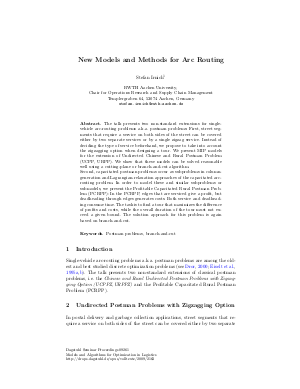New Models and Methods for Arc Routing
Author Stefan Irnich
-
Part of:
Volume:
Dagstuhl Seminar Proceedings, Volume 9261
Part of: Series: Dagstuhl Seminar Proceedings (DagSemProc) - License:
 Creative Commons Attribution 4.0 International license
Creative Commons Attribution 4.0 International license
- Publication Date: 2009-10-02
File

PDF
DagSemProc.09261.18.pdf
- Filesize: 269 kB
- 5 pages
Document Identifiers
Subject Classification
Keywords
- Postman problems
- branch-and-cut
Metrics
- Access Statistics
-
Total Accesses (updated on a weekly basis)
0Document
0Metadata
Abstract
The talk presents two non-standard extensions for single-vehicle arc-routing problems a.k.a. postman problems: First, street segments that require a service on both sides of the street can be covered either by two separate services or by a single zigzag service. Instead of deciding the type of service beforehand, we propose to take into account the zigzagging option when designing a tour. We present MIP models for the extension of Undirected Chinese and Rural Postman Problem (UCPP, URPP). We show that these models can be solved reasonable well using a cutting-plane or branch-and-cut algorithm. Second, capacitated postman problems occur as subproblems in column-generation and Lagrangian-relaxation approaches of the capacitated arc-routing problem. In order to model these and similar subproblems or submodels, we present the Profitable Capacitated Rural Postman Problem (PCRPP): In the PCRPP, edges that are serviced give a profit, but deadheading through edges generates costs. Both service and deadheading consume time. The task is to find a tour that maximizes the difference of profits and costs, while the overall duration of the tour must not exceed a given bound. The solution approach for this problem is again based on branch-and-cut.
Cite As Get BibTex
Stefan Irnich. New Models and Methods for Arc Routing. In Models and Algorithms for Optimization in Logistics. Dagstuhl Seminar Proceedings, Volume 9261, pp. 1-5, Schloss Dagstuhl – Leibniz-Zentrum für Informatik (2009)
https://doi.org/10.4230/DagSemProc.09261.18
BibTex
@InProceedings{irnich:DagSemProc.09261.18,
author = {Irnich, Stefan},
title = {{New Models and Methods for Arc Routing}},
booktitle = {Models and Algorithms for Optimization in Logistics},
pages = {1--5},
series = {Dagstuhl Seminar Proceedings (DagSemProc)},
ISSN = {1862-4405},
year = {2009},
volume = {9261},
editor = {Cynthia Barnhart and Uwe Clausen and Ulrich Lauther and Rolf H. M\"{o}hring},
publisher = {Schloss Dagstuhl -- Leibniz-Zentrum f{\"u}r Informatik},
address = {Dagstuhl, Germany},
URL = {https://drops.dagstuhl.de/entities/document/10.4230/DagSemProc.09261.18},
URN = {urn:nbn:de:0030-drops-21635},
doi = {10.4230/DagSemProc.09261.18},
annote = {Keywords: Postman problems, branch-and-cut}
}
